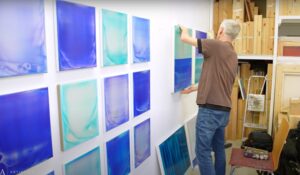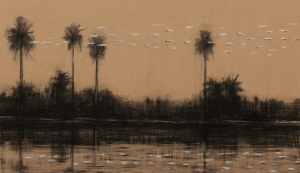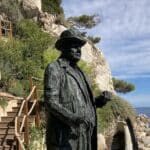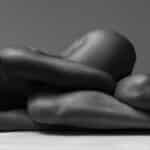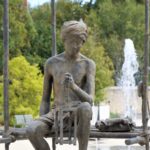
X,Y,Z by Mattia Bosco, marble sculpture, 111.5 cm × 179 cm × 47 cm
In this interview, carried out in May 2021, Italian sculptor Mattia Bosco tells more about his career, his creative process as well as his vision of art and its recent developments. By doing so, he allows us to become better acquainted with his work, but also to grasp the deep reflection from which it is originated.
Your background in terms of coming from an artistic family and studying philosophy seems to have shaped your development as an artist. Could you explain how these different experiences influenced your work?
Coming from a family of painters did shape me. But it was an almost unremembered process that began with my mother’s milk, the smells, the way things were placed in the house… There was no myth of the artist, in fact it seemed more like a flaw, but art, in the sense of the works themselves, was sacred. For me my parents being artists was normal, but without anyone ever saying so, a certain pride was implicit in this freedom, which obviously has a price to pay for it.
I think there is some wisdom in the decision not to push a young person still in the phase of development towards one path rather than another, even more so when it’s a path to art. These are choices that should mature inside, so much so that one can’t know when and how they’re made. You make the choice when you realize you’re already acting it out, and then when you look back, you see that a combination of apparently unconnected conditions and events have sketched out your constellation. In other words, you notice you’re involved in it when you’re already doing it and this is just why you notice that’s never it, or rather you’re only something that’s becoming, becoming what you are. It’s the works that encourage you to become one more time, to do it again, but the works never say who you are or assure you of an identity.
So, I might say that all the time I was growing up and up until university I would never have said I’d be a sculptor. I studied philosophy and it was precisely by doing something else, I mean going on with my studies, that at one point I found myself on a diagonal that was leading me back towards art. So, what had been removed returned, and everything I’d learned by osmosis, especially by watching my mother at work, turned out to be a competence I’d never learned at any school. My hands knew the right questions to ask of the material I was working on and she replied. And so, I found myself watching as the whole reserve of latent forms that had filtered into me, like I said at the beginning with my mother’s milk, were now surfacing.

Kora I by Mattia Bosco, Palissandro Marble, 142 cm × 63 cm × 34 cm
What materials have and still trigger you the most? What are the limitations and the challenges?
There are two materials that always attract me, for opposite reasons I’d say: stone and clay. Clay has a quality that’s very similar to water: it lets things in, makes room. The ease with which clay lets itself be manipulated degenerates just as easily into a plastic outburst and the gesture impressed upon it gets confused by continuously going over and over its own tracks. This is why clay is only apparently easy, whilst perhaps it just leads more easily to making mistakes. It takes on shape but has no shape and this is the limit I find in it – a limit that nonetheless allows for endless inner boundaries. Instead, to me stone is so full of form that I can’t even bring myself to consider it a material. Its very hardness leads to a slow and careful approach and this is why it’s actually quite hard to make a mistake.
The concept of error itself in my way of working assumes the significance not of failure to achieve an idea, compromising the project, but of failure to adapt to the responses of the stone, suffocating its dawning potential, a misalignment between my intervention and its own nature. To me every stone has its own nature and that’s why considering it a material is like seeing an animal as meat.
Every stone is a fragment of the world, part of a whole alluded to by the veining in it. There are stones that are virtually the same age as our planet: the idea of working on 4.5- billion-year-old basalt makes your head spin.
Your sculptural practice is mostly described as abstract, although you work with forms and materials that are easily found in the nature. Is this tension between the unarticulated or even surreal thoughts and concrete manifestations a starting point for the exploration of form?
As I’ve just said, stones are pieces of world, epidermic flakes that have detached from the mountains. All I do is collect them. We might say that this gesture, this choice, is just about taking them away from a place and implies the act of detaching them from an environment. In this sense, the action can be termed an abstraction. When I take a single stone from a quarry, for her movement starts, whilst all the others stay where they are. To me there is nothing shapeless about that stone and there’s no need for her to assume a human likeness, because I acknowledge value in her. It’s sufficient to place her in an upright position for her to be humanized. At that stage a last but fundamental phase is needed: to give her a voice, make her sing, so that everyone can hear her. And more than an act of abstraction, this is an act of translation.
And this is what I try to do, picking out the lines, the shifts in planes, just below the surface, as though it were sufficient to peel the stone, removing a veil that has stopped us from seeing her. I put gold laminate, like a ray of light to reveal them better – an accent. I just invite people to look at it, getting rid of the superstructures that stop us seeing it. To me gold is light in its solid state.

SW3 by Mattia Bosco, Palissandro marble and gold leaf, 45 cm × 39 cm × 22 cm
he impression is that your entire approach is rather conceptual. Could you share your thoughts on your process? Are you trying to speak about geology, perhaps alchemy, or other disciplines with your works?
Many conceptual artists may have the actual work done by craftsmen or ‘suppliers’ as they say today. I could never have my sculptures made by other people, I wouldn’t know what to tell them, or what I said would be too vague. Everything in my work is based on a body-to-body encounter between me and the stone, considered as two pieces of world that become hybrid, contaminate one another. Fortunately, there’s a gap between the idea and the work, that makes the work far richer than the idea. Any idea that wishes to become effectively grafted into it must accept the fact that it’s a spark that will be eaten up by the rising fire.
Do you consider yourself a person interested in contemporaneity and is it at all relevant for your work?
It isn’t sufficient to live in 2021 to be contemporary. The flow must fade, time has to hemorrhage into eternity to be perceived. Otherwise we are inside time, we are temporary but not contemporary. I don’t think it would even be possible to make art if you didn’t have one foot in the time you’re living in and one foot outside. A more or less evident part of an artist’s work can be traced back to their time but part of it remains untraceable, irreducible, inexhaustible. There is a non-quantifiable debt to be confronted, an account open between yourself and life. If you like, my work can be seen in this perspective, as the metaphor for a possible way to inhabit the world differently.

SW12 by Mattia Bosco, Black Palissandro marble, 56.5 cm × 42 cm × 20 cm
How do you perceive new modes of presentation and consumption of art in a digital era? Does it affect a possible interaction with your work?
I think all ways of presenting and experiencing art in a purely digital mode, as a substitute for the live mode, are lacking in something, but in terms of integration potential may emerge that has yet to be developed. I would love to make a sculpture that is partly real and partly a holograph, where the hologram would give back the image of what it was like before my interventions. Technology won’t allow me to do that yet.
Could you share your plans for the future?
To work as much as possible and, when it’s possible again, to travel the world in search of stones. First stop: Iran. Making plans is not really in line with the period we’re going through, but I do have two exhibitions on the cards for 2022.
